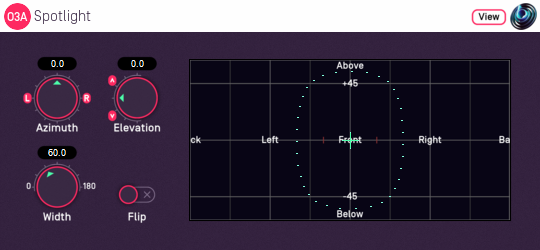O3A Spotlight

Host Support
| Host Type | Support |
|---|---|
| AAX | Yes |
| VST2 | Yes |
Audio
| Channels | Content | |
|---|---|---|
| Input | 16 | O3A |
| Output | 16 | O3A |
Controls
Description
This plugin can be imagined as a spotlight being applied to a direction in an O3A audio scene. Lit parts of the scene are kept and unlit parts are removed. The width of the spotlight beam can be controlled.
This plugin has features in common with the the O3A Directional Emphasis and O3A Directional Mask plugins, but aims for a cleaner transition between its lit and unlit regions. Typically, this makes it more suitable for isolating sounds in a particular region.
The spotlight direction can be set using the azimuth and elevation controls, or the control surface, where the direction is indicated by the crosshairs.
There are labels on the control surface to help you find left, right, above etc. However, if this still does not make any sense, you might want to see our page on the O3A Visualiser which lays out its viewing region in the same way.
The algorithm used is a "passive" one and should not colour the frequency content of the sound significantly.
The plugin is available in the O3A Manipulators plugin library.
View Support
When used with O3A View Sync from the O3A View library, this plugin can be connected to the separate View or ViewVR applications.
When this option is available, a 'View' button appears at the top right of the plugin's user interface.

When this is pressed, the plugin is connected to the View or ViewVR application and is displayed there.
| View Support | ViewVR Support |
|---|---|
The current direction is shown using a cross. Hold the left mouse button to set the azimuth and elevation. | The current direction is shown using a beam and cross. Hold a VR controller trigger to set the azimuth and elevation. |
Controls
Controls: Azimuth and Elevation
Azimuth and Elevation control the direction to be isolated.
Azimuth is the horizontal angle, between -180 to +180 degrees, measured anticlockwise (left) from the front. Elevation is a vertical angle between -90 and +90 degrees, measured with positive upwards and 0 on the horizontal.
For instance, the direction for azimuth +90 and elevation +45 can be found by turning 90 degrees to the left and then looking up by 45 degrees.
Control: Width
Width is an angle, between 0 and 180 degrees, indicating how wide the beam of the spotlight should be. An angle of 0 indicates a narrow beam and an angle of 180 encompasses the whole scene.
Angles are measured from the spotlight direction to the sound direction. When the angle is less than the width setting, the sound is in the lit region and should be kept. Other sounds are in the unlit region and should be attenuated. In practice, the transition from the lit to unlit region is a gradual slope rather than a hard transition.
Control: Flip
Enabling this switch flips the meaning of the lit and unlit regions.
- O3A A20->B Converter
- O3A B->A20 Converter
- O3A Compressor
- O3A Diffuser
- O3A Directional Emphasis
- O3A Directional Mask
- O3A Graphic Equalizer
- O3A Join
- O3A Line
- O3A Low/High Pass Filter
- O3A Move
- O3A Order Amplifier
- O3A Panner LS
- O3A Panner LS XYZ
- O3A Panner LS8
- O3A Parametric Equalizer
- O3A Portal
- O3A Reflection
- O3A Screen Resizer
- O3A Spatial Equalizer
- O3A Spatial Mask
- O3A Spatial Mask Split
- O3A Spotlight
- O3A Spotlight Split
- O3A Swap
- O3A Zoom
- O3A Zoom XYZ
